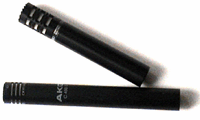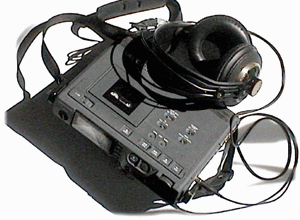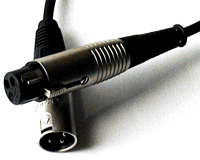Film Sound Equipment
Microphones used for film
Usually the sound on set or location that is desired to be captured is the dialogue of the actors. Sometimes this is the only sound that is to be captured to the exclusion of all other sound. For this purpose a highly directional microphone should be used. There are: cardioid, super cardioid and hyper cardioid microphones to be considered. The term cardioid refers to the shape of the pickup pattern in front of the microphone. The term "cardioid" refers to a heart shaped pattern worth the point or bottom of the heart pointing out in front of the microphone. The "super" and "hyper" terms reference and elongation of the the heart shape pick up pattern. This pattern is characterized as being more sensitive to sound inside the pattern and less sensitive out side the pattern. The longer and more narrow the pattern the more directional it is. However, sometimes all the sound that is created on location or set needs to be recorded. For this purpose a omni directional microphone should be used. Again the "omni" refers to the pickup pattern of the microphone and in this case it picks up sound equally in every direction. When a microphones Pickup pattern has been determined consideration can be given to the type of element the microphone employs to actually capture sound. The two main types to be considered for the scope of this article are "condenser" also called capacitor or electrete, and "dynamic."
Dynamic microphones are rugged, affordable and do not required any special consideration like power source. But they often are limited in frequency range and fidelity of sound reproduction. They often "color" sound. This sound coloration while often bad may also be good. Since movie goers and radio listeners have been hearing sound recorded using colored dynamic microphones for so long they have become accustom to their sound. In fact, some times when high quality microphones are used in recording applications the sound can be "to accurate" and sound relatively unpleasant to the average listener. Some famous dynamic microphones that have favorable coloring are the Sure SM-58 and SM-57. These two mics have a cardioid pickup pattern so they will not work well for a boom mic but can be excellent for voice over and foley applications.
Condenser microphones are delicate, require a power source and often are very costly. But they can be a very good microphone. Good ones produce very smooth and wide frequency responses that are often much more accurate than dynamic microphones. Condenser mics can also have "coloration" and like the dynamic mics this coloration can be desirable. Some condenser mics that have desirable coloration can cost 10 to 15 times what a good dynamic mic can cost, but these are often large diaphragm studio mics good for voice over, or foley only. They are often so large and fragile that they would quickly break if suspended from a boom. However, small diaphragm condenser mics make excellent microphones for use in motion pictures. Sony (professional) Audio Technica, and Sure are some of the brands of great microphones used for motion picture work.
Recorders used for film
DAT (digital audio tape) recorders are by far the most common type used for motion picture work, though the new flash based recorders are quickly taking their place. Tascam makes portable DAT deck that are durable, battery powered, have phantom power to power condenser mics, have XLR inputs, have digital in and outputs in the form of SPDIF, and are relatively small so they can be worn by the boom operator. owyheesound uses the Tascam DA-P1. Traditionally analogue tape machines were used like Nagra or Stellavox tape decks. These were 1/4 inch reel to reel tape decks that while portable were to heavy for the boom operator to wear and could be prone to break downs. They were also very expensive, and still are, but brands like Nagra have upgraded to digital and still are the very best in motion  picture sound recorders. These days, however, hard disk recorders are making their way to motion picture sets. These are small portable hard drives that have AD (analogue to digital) audio converters built in. While some very costly professional systems have XLR inputs and phantom power, the small more affordable units requires a separate portable mixers to connect a microphone to to the recorder and power the mic, if needed.
picture sound recorders. These days, however, hard disk recorders are making their way to motion picture sets. These are small portable hard drives that have AD (analogue to digital) audio converters built in. While some very costly professional systems have XLR inputs and phantom power, the small more affordable units requires a separate portable mixers to connect a microphone to to the recorder and power the mic, if needed.
Miscellaneous Equipment used in Film
The Boom is the long extendable pole that is used to suspend the microphone near the source of audio to be recorded. Sometime the boom is mounted to self standing support but is usually held by a "boom operator." There is not much to consider here, the boom needs to be extendable, and needs to be able to attach to a shock mount and or blimp in which the microphone is held or attached. Foam grips are also a sign of quality and usability.
There are two types of Blimps for motion picture making. One is a sound proof case that a noise camera is placed in to keep that cameras noise from ending up on the sound recording. The other is a Zeppelin shaped wind screen that fits around a microphone and is absolutely necessary for a good recording especially if the sound recording is to be done out side.

Cables are rarely given the consideration they need. For connecting a good microphone to a mixer or directly to a good recorder balanced cables are used that have XLR connectors. XLR is a standard connector developed by Canon. There are a male and female variety. The male connector has the diameter of a US nickel and has three pins that are received by the female connector. The term "balanced" refers to the cable having a positive and negative wire that caries the positive and negative portion of the audio signal. These are encased by a grounded shield that prevents the signal carrying wires from acting like an antennae and introducing stray radio signals into the audio recording. Balanced is to be differentiated from "unbalanced" which is a signal wire encased in a shield. These cables are only good for short runs and they tend to pick radio interference. Balanced cables can be run for great distances with out picking up unwanted noise.
Tone Generators are not used today with as much frequency as they once were. They were typically used to establish the operating speed of a recorder. This was done by recording a tone of a specific frequency onto the tape used to record the source signal. Later when the tape would be synchronized with film the tone was used to determine the playback speed to set the play back tape machine at. Tone generators also have other uses. For instance tone generator can be connected to a slate (clap board) to give a precise burst of sound fed directly to the recorder. This is more accurate that recording the sound of the clap as sometimes the clap can be at such a distance from the recorded sound as to introduce a noticeable delay in the play back.
Baffles are sound barriers used to control sound on a set. In a room with hard surfaces for walls, ceiling, and floor there are many echoes that occur from any sound made in that room. These echoes make the intelligibility of the dialogue decrease, meaning it is hard to understand the speakers. To reduce the echoes and make a more useable sound recording sound absorbing baffles should be used.
Shock Mounts are the vibration absorbing suspension used to hold a microphone. Theses are especially important if the microphone is to suspended in a hand held boom. The shock mount does much of its work absorbing the low frequency rumble of simply being moved about in the air, it also reduces the hand noise of the boom operator.
Phantom Power is the term used to describe the power source used to power condenser microphones. Phantom power is often found on audio mixers of fair to good quality and on professional recorders. If a recorder and or mixer is used that does not have phantom power a separate phantom power unit may be acquired. Phantom power is typical a 48volt DC current. Sometimes condenser microphones do not require phantom power as they have internal batteries that supply there inner workings with the desired current.
One other consideration in selecting a microphone for film production
"Speech intelligibility" is the term used to describe how understandable the words are in a recording. As it happens the human perception of hearing is very sensitive to the frequency range between 1kHz and 3kHz or there about. This is also the frequency range that many of the sounds made by the human mouth are centered around. These are not the sounds of the vocal chords but the sounds made by the lips, tongue and teeth. The "coloration" that mics can have can be in this frequency range. Microphones that have a 3 or 4db boost in this frequency range are very desirable for voice reproduction and are very useful for dialogue. If a microphone does not have this colored frequency response it can be created by selecting these frequency range on a mixers eq and increasing the gain by a few db. Very elaborate methods can also be employed like splitting a dialogue track into and routing one of those tracks to a band pass filter set to pass the speech intelligibility spectrum and then compress that signal and mix it back with the original signal. This effect does not increase the overall volume but does increase the "intelligibility" of the signal.



 picture sound recorders. These days, however, hard disk recorders are making their way to motion picture sets. These are small portable hard drives that have AD (analogue to digital) audio converters built in. While some very costly professional systems have XLR inputs and phantom power, the small more affordable units requires a separate portable mixers to connect a microphone to to the recorder and power the mic, if needed.
picture sound recorders. These days, however, hard disk recorders are making their way to motion picture sets. These are small portable hard drives that have AD (analogue to digital) audio converters built in. While some very costly professional systems have XLR inputs and phantom power, the small more affordable units requires a separate portable mixers to connect a microphone to to the recorder and power the mic, if needed. Cables are rarely given the consideration they need. For connecting a good microphone to a mixer or directly to a good recorder balanced cables are used that have XLR connectors. XLR is a standard connector developed by Canon. There are a male and female variety. The male connector has the diameter of a US nickel and has three pins that are received by the female connector. The term "balanced" refers to the cable having a positive and negative wire that caries the positive and negative portion of the audio signal. These are encased by a grounded shield that prevents the signal carrying wires from acting like an antennae and introducing stray radio signals into the audio recording. Balanced is to be differentiated from "unbalanced" which is a signal wire encased in a shield. These cables are only good for short runs and they tend to pick radio interference. Balanced cables can be run for great distances with out picking up unwanted noise.
Cables are rarely given the consideration they need. For connecting a good microphone to a mixer or directly to a good recorder balanced cables are used that have XLR connectors. XLR is a standard connector developed by Canon. There are a male and female variety. The male connector has the diameter of a US nickel and has three pins that are received by the female connector. The term "balanced" refers to the cable having a positive and negative wire that caries the positive and negative portion of the audio signal. These are encased by a grounded shield that prevents the signal carrying wires from acting like an antennae and introducing stray radio signals into the audio recording. Balanced is to be differentiated from "unbalanced" which is a signal wire encased in a shield. These cables are only good for short runs and they tend to pick radio interference. Balanced cables can be run for great distances with out picking up unwanted noise.